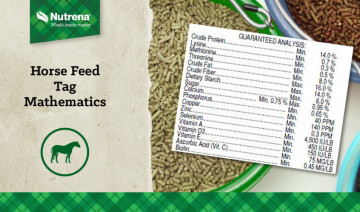
Horse Feed Tag Mathematics
We often receive questions from horse owners, wondering what the various units of measure on horse feed tags mean, and how they can use those units to figure out what their horse is consuming…and wondering why in the world they have to be so confusing, too!
In short, feed companies use the units of measurements on nutrients that we do, because we are required to. Why? Because horse feeds and other livestock feeds are labeled as required by AAFCO (American Association of Feed Control Officials) and the various state Feed Control regulations. These regulatory bodies establish the units which are to be used for each nutrient in tag guarantees.
To break it down, there are 4 common units used on feed tags. To help you understand them all, here’s a quick overview of how they work, along with examples of how to do the appropriate math:
Protein, amino acids, fat, fiber and macro minerals (calcium, phosphorus, magnesium and potassium) are listed as a % minimum or maximum.
- To calculate the amount supplied per pound, you can convert % to a decimal fraction by moving the decimal point 2 places to the left, then multiply by the pounds fed.
- As a horse’s daily intake requirements are sometimes given in grams, we can convert those pounds of intake to grams as well.
- For those of us that are mathematically challenged, a quick Google search of “pounds to grams” will provide a handy conversion calculator!
Example:
- A feed that is 14% protein would contain 1 lb x 0.14 = 0.14 lb of protein in 1 pound of feed.
- If you want to measure in ounces, there are 16 ounces per pound, so the same pound of feed would contain 0.14 x 16 = 2.24 ounces of protein.
- If the requirements are given in grams, we know that there are 453.6 grams per pound, so the feed would contain 453.6 x 0.14 = 63.5 grams of protein per pound of feed.
- Feeding 5 lbs of this feed per day, results in feeding 0.7 lbs, or 11.2 ounces, or 317.5 grams, of protein per day.
Trace minerals (copper, zinc, manganese and selenium) are expressed as “ppm” or parts per million.
- One part per million is the same as one milligrams per kilogram.
- 1 kilogram = 2.2 pounds.
Example:
- Premium horse feeds are commonly tagged at 0.6 ppm selenium.
- This is 0.6 mg/kg of feed. This equals 0.273 mg per pound of feed.
- 0.6 mg/kg divided by 2.2 kg/lb. = 0.273 mg per pound of feed
- Feeding 5 lbs of this feed per day, results in feeding 1.365 mg per day of selenium.
Vitamins A, D and E are expressed in IU/lb.
- An IU is an International Unit and is based on the effectiveness of a particular vitamin.
- There are some rather complicated conversions of different Vitamin sources to International Units, which is why animal requirements are given in International Units, so no further conversion is needed.
Example:
- A feed that lists 100 IU/lb of Vitamin E, fed at 5 lbs per day, provides 500 IU’s per day.
Vitamin C (or Ascorbic acid) and Biotin are normally expressed as mg/lb or milligrams per pound.
- Usually only tagged on senior horse feeds.
- Requirements are in mg of intake per day, so no further conversion is needed.
Example:
- A feed that lists 75 mg/lb of Vitamin C, fed at 5 lbs per day, provides 375 mg per day.
Still confused? Don’t worry about it. Just leave us your questions in the comments section below, and we’ll be happy to help you out!
The feed room is proudly brought to you by Nutrena and Cargill Animal Nutrition. Learn more about us here. You can see the original blog post here.
